Effects of nitrogen application on the growth and yield of quinoa under saline conditions in Northern Vietnam
This study aimed to determine the optimum nitrogen application rate
for quinoa in saline soils. Two experiments were conducted: (i) the
first experiment was under artificial saline conditions with the two
factors of saline regime (stressed and non-stressed) and nitrogen
application level (0, 30, 60, 90 and 150 kg N ha-1) in net-houses
located in Gia Lam, Hanoi; and (ii) the second experiment was under
natural field saline conditions with the two factors of quinoa cultivar
(Atlas and Moradas) and nitrogen application level (0, 30, 60, 90, and
150 kg N ha-1) in the coastal areas of Hai Hau, Nam Dinh province.
Data were collected for growth duration, insect and disease
infestations during the growth period, and various growth parameters
and yield components at harvest. The results showed that saline stress
reduced the growth and yield parameters, but did not affect the quinoa
growth duration of the investigated quinoa cultivars. In both
experiments, the growth parameters and yield components increased
according to the increase of the nitrogen application rates from 0 to
90 kg N ha-1, then decreased when the nitrogen rates were higher. The
results suggested that 90 kg N ha-1 was the optimum nitrogen
application dose for quinoa growth and development under saline soil
conditions.
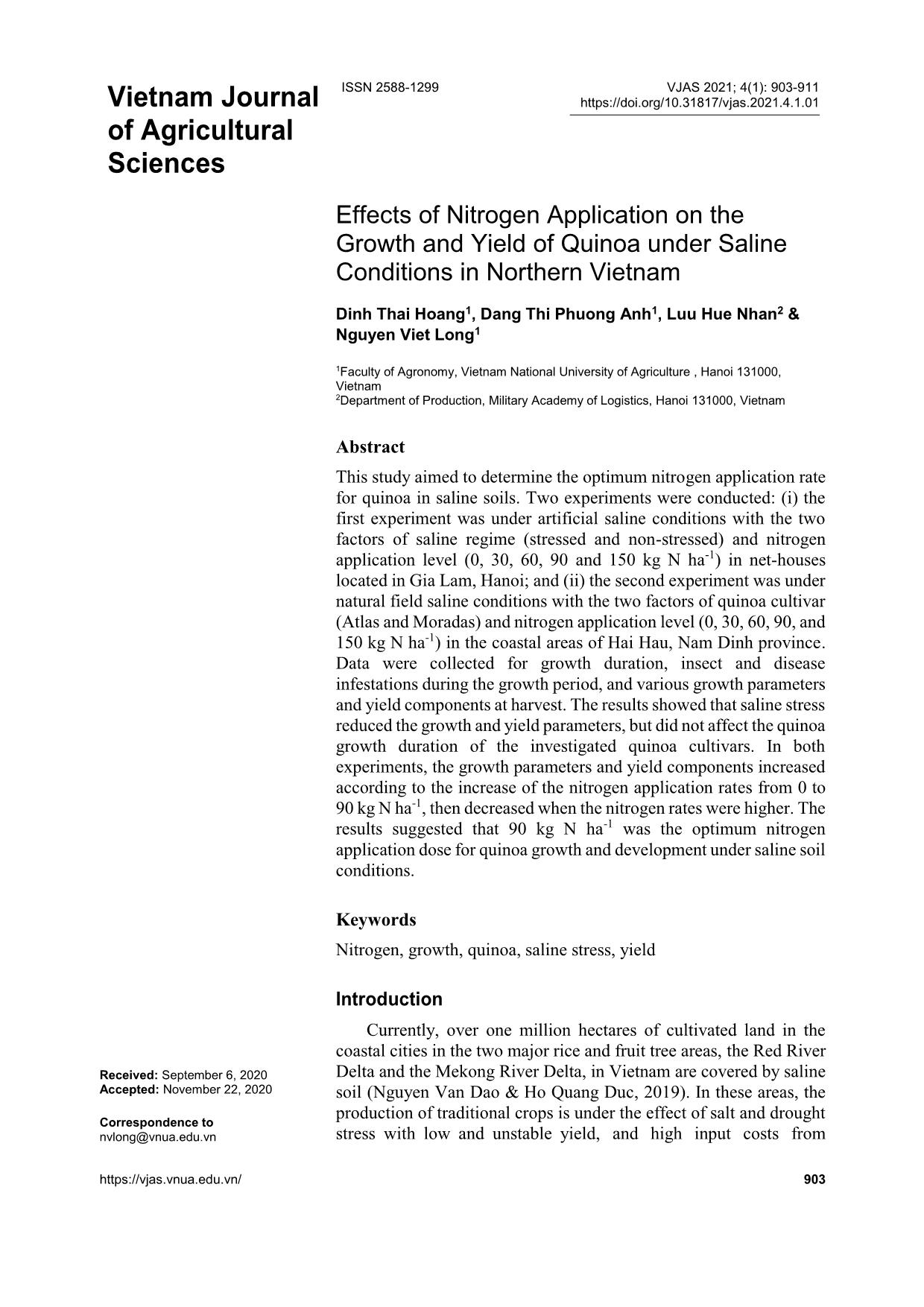
Trang 1

Trang 2
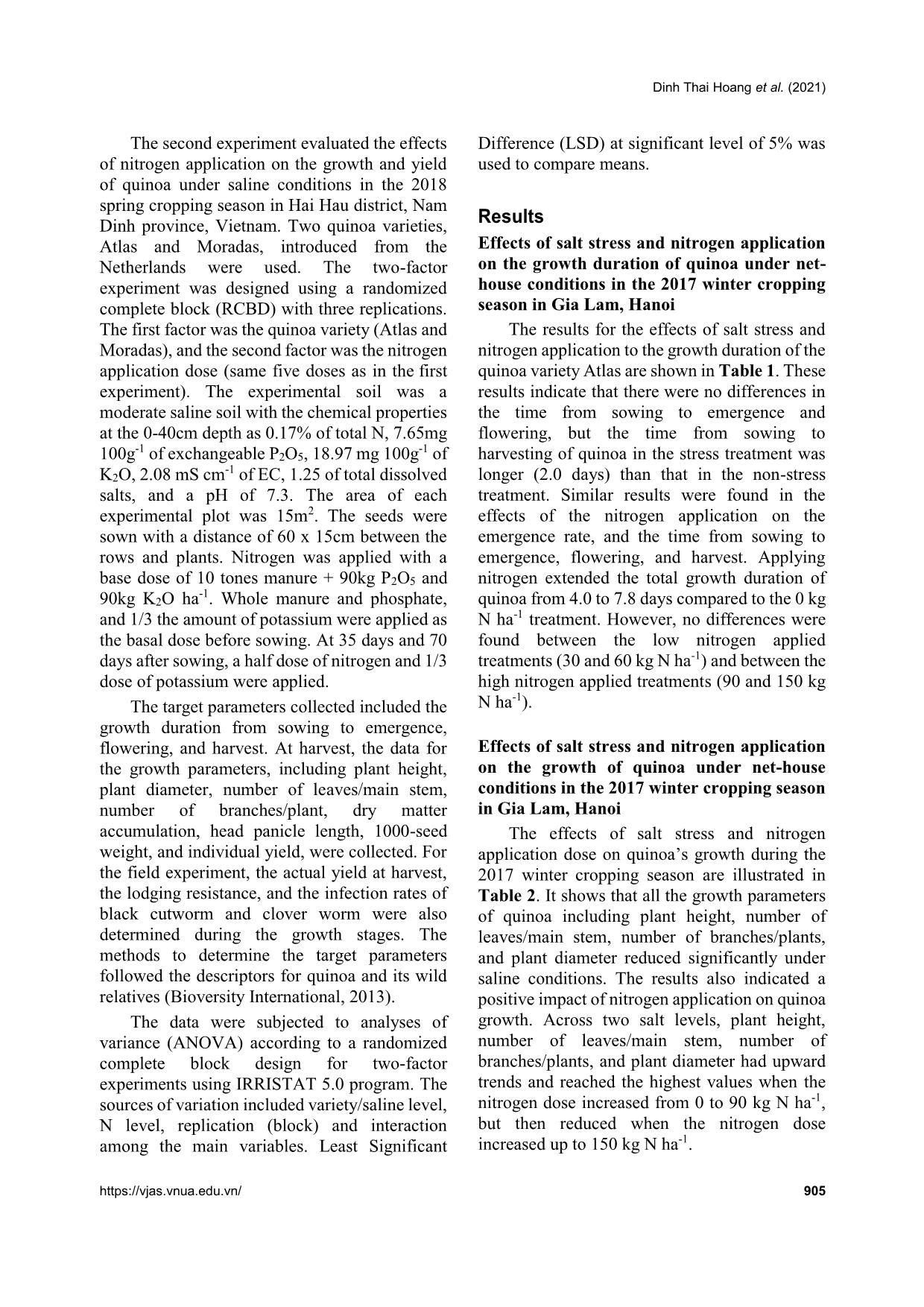
Trang 3
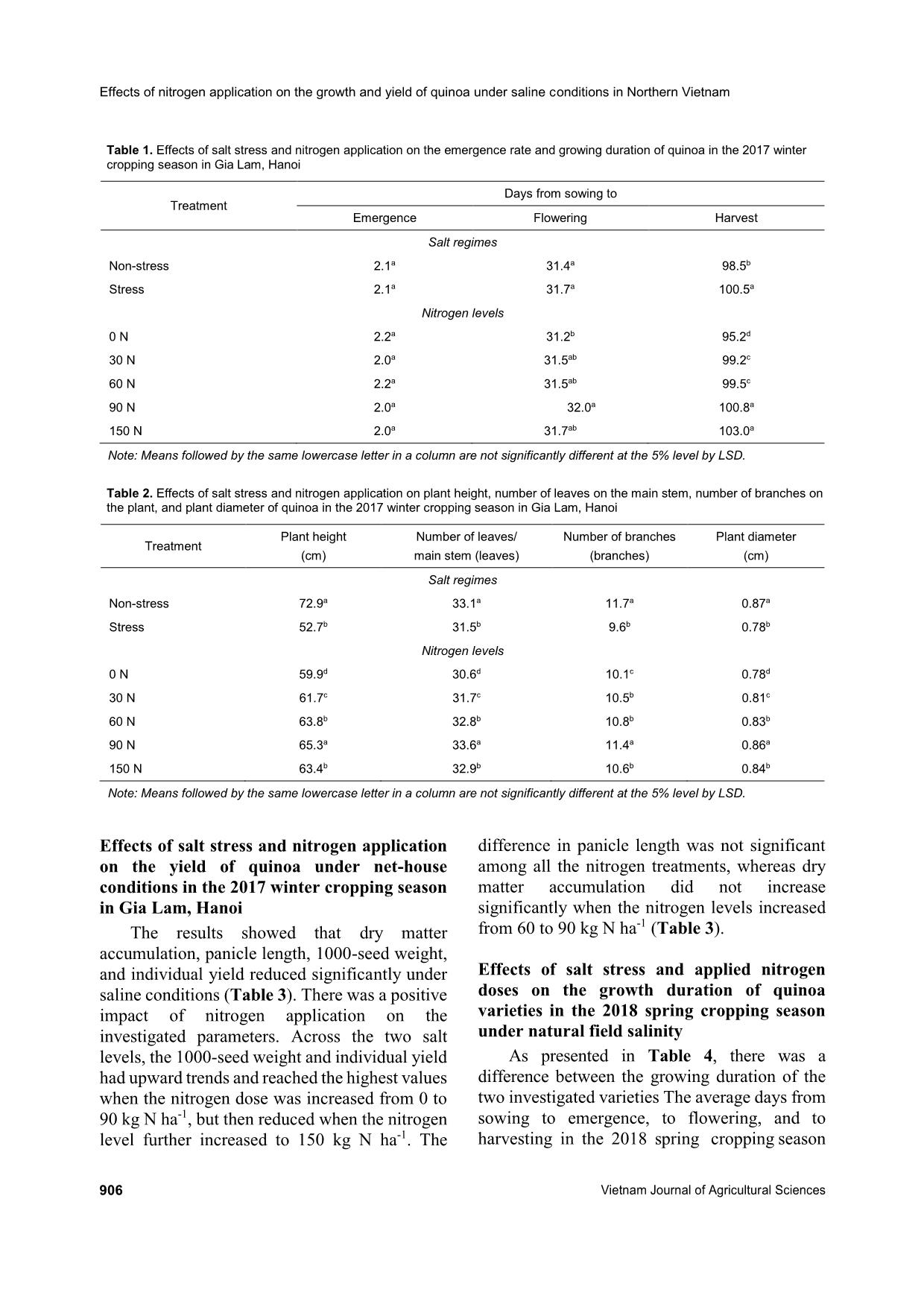
Trang 4
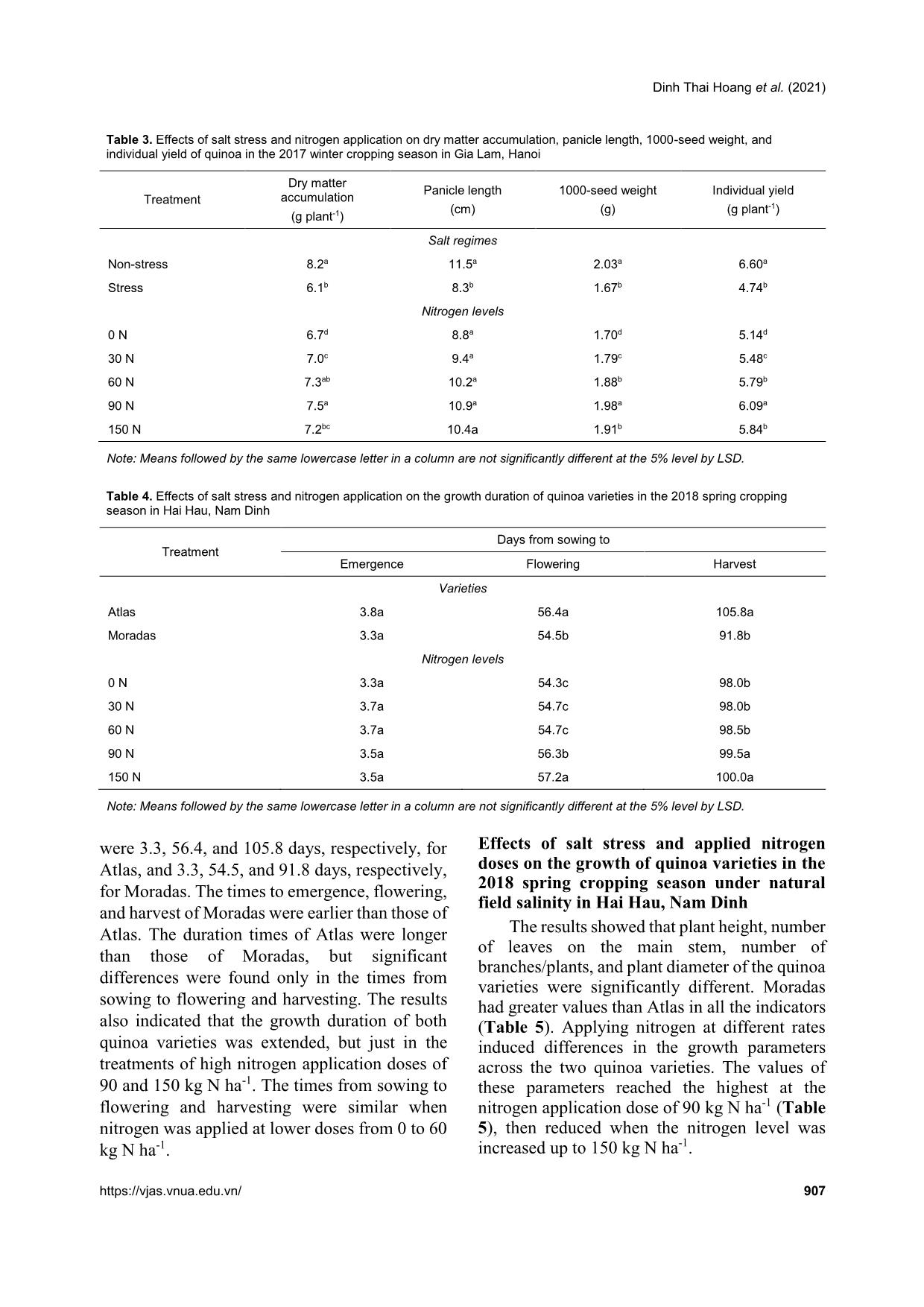
Trang 5
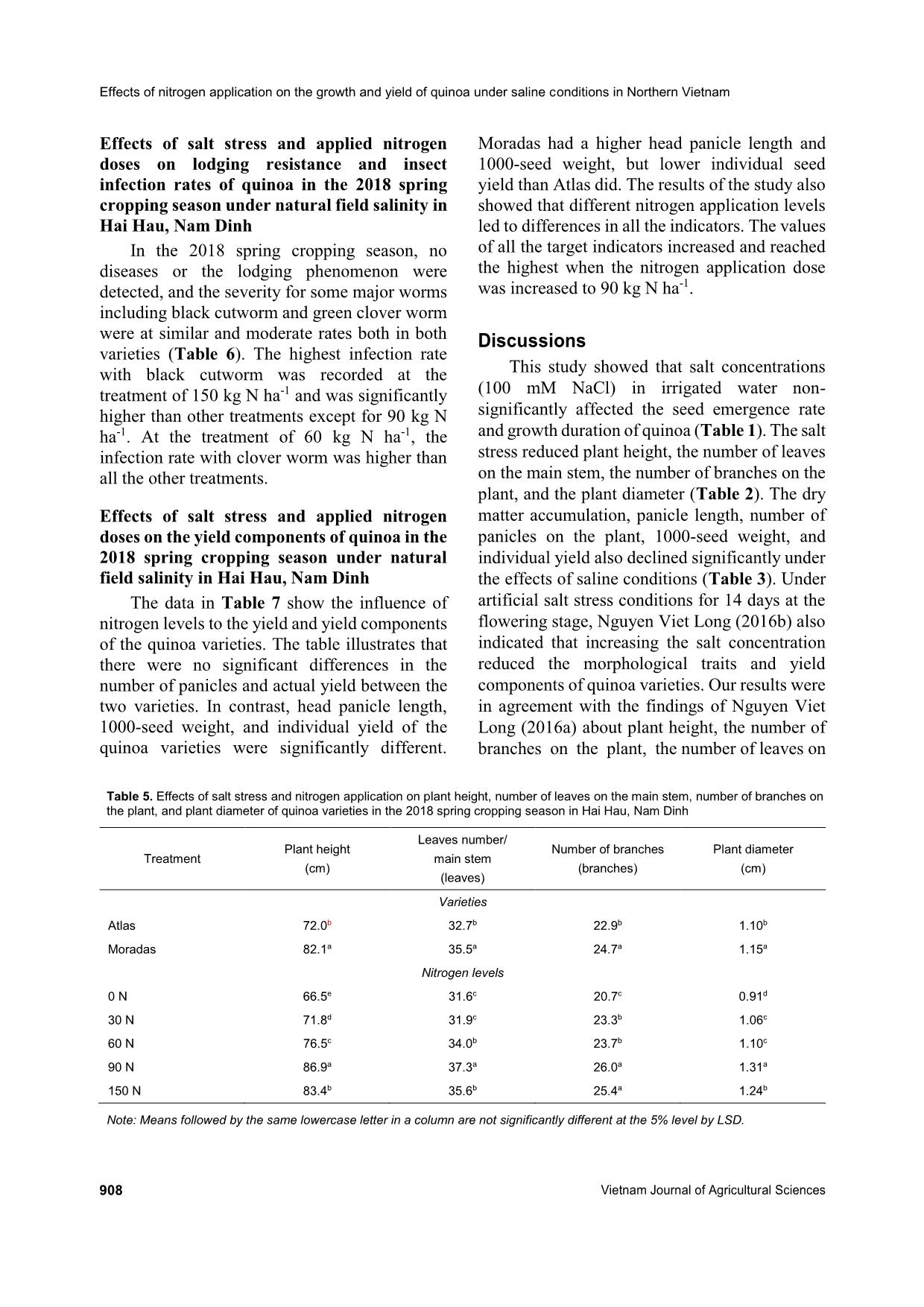
Trang 6
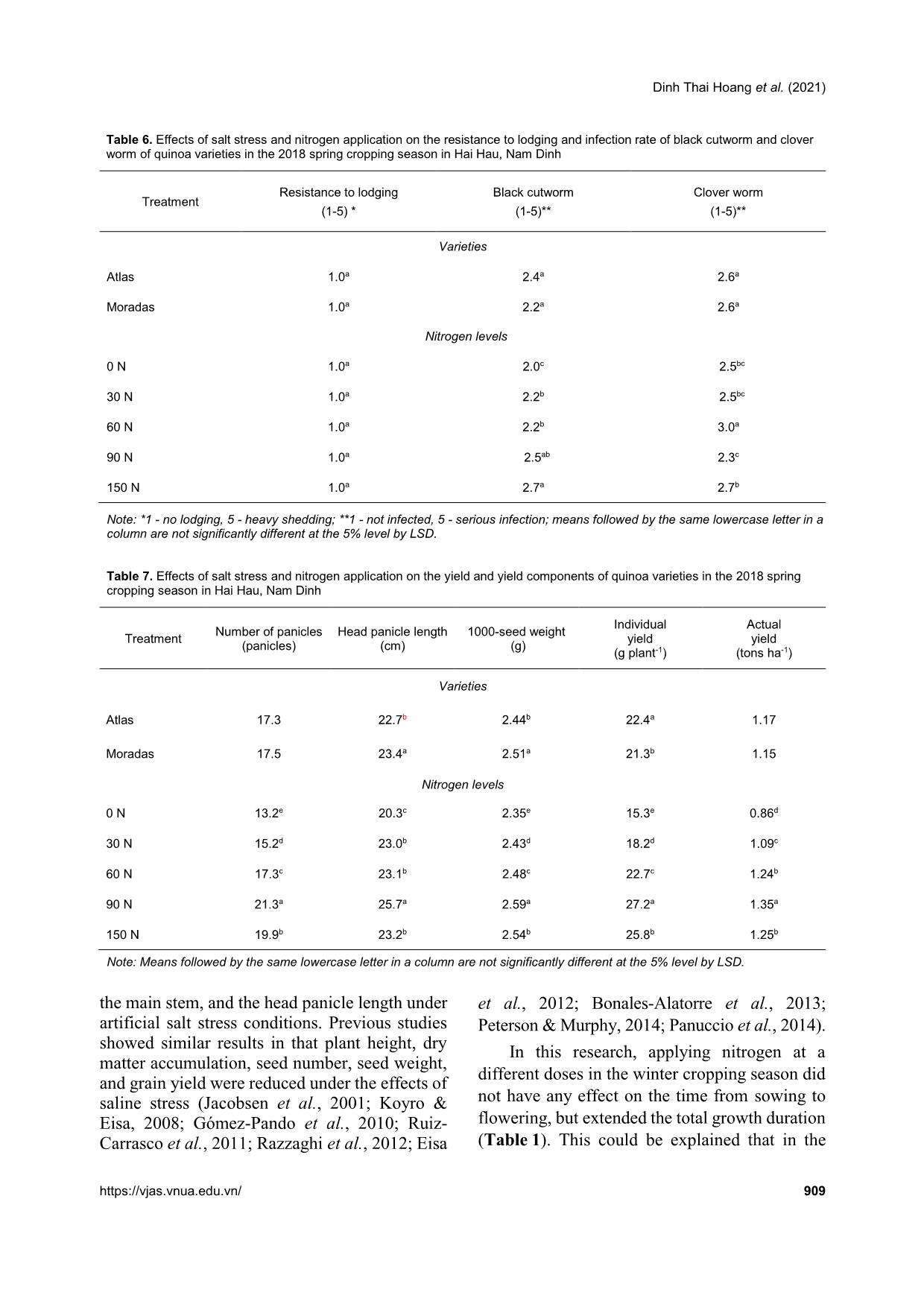
Trang 7
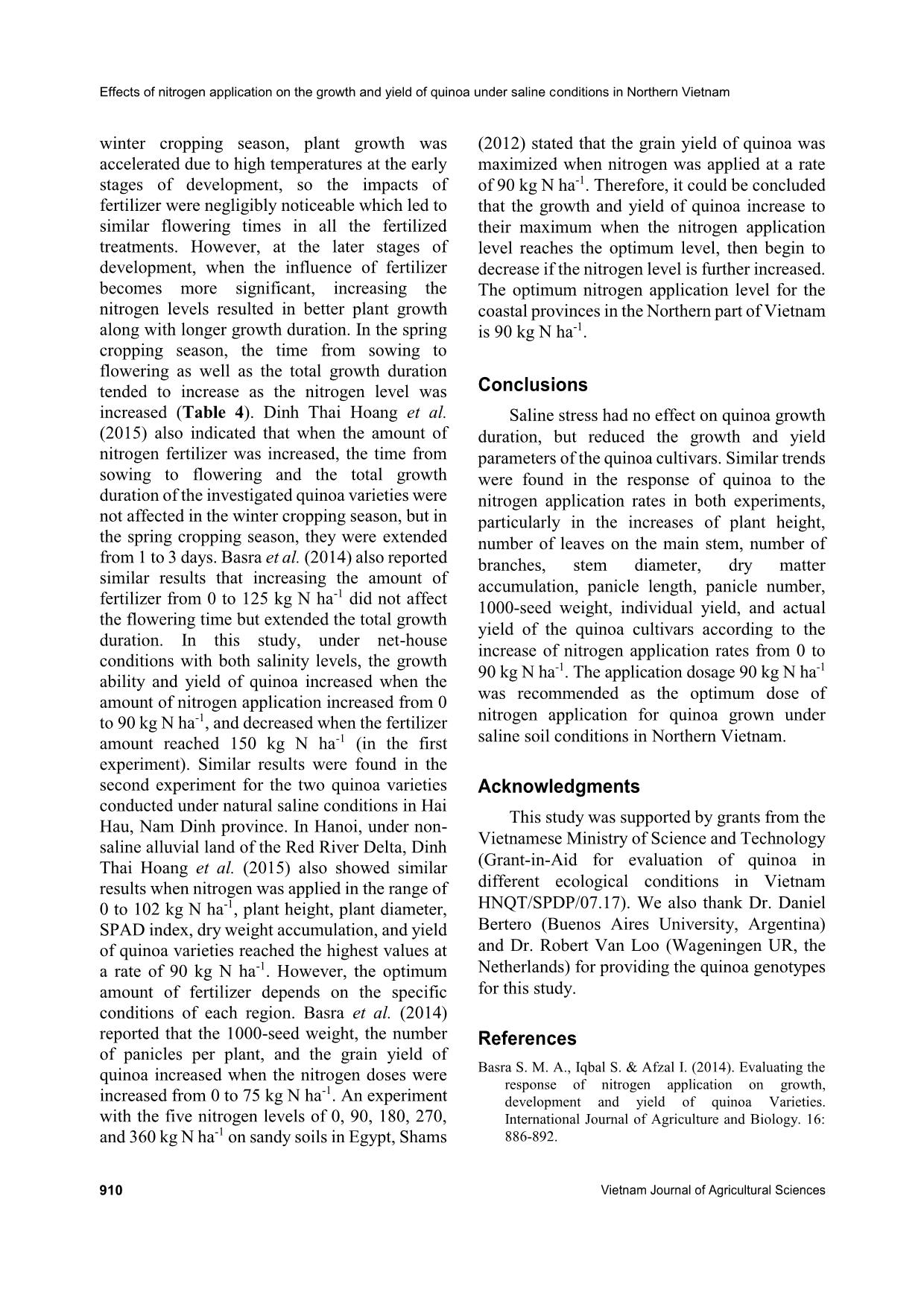
Trang 8
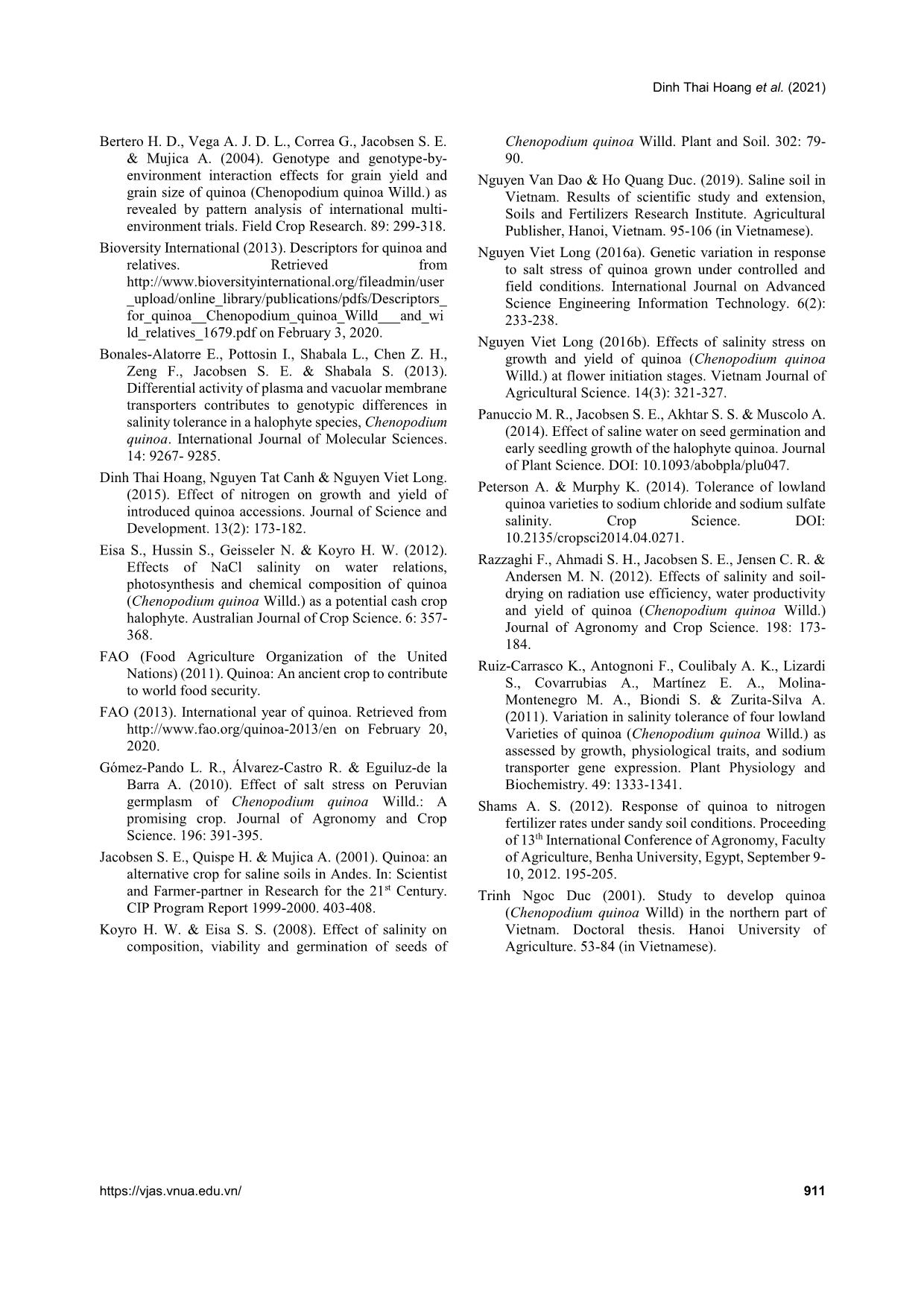
Trang 9
Tóm tắt nội dung tài liệu: Effects of nitrogen application on the growth and yield of quinoa under saline conditions in Northern Vietnam

nitrogen at different rates induced differences in the growth parameters across the two quinoa varieties. The values of these parameters reached the highest at the nitrogen application dose of 90 kg N ha-1 (Table 5), then reduced when the nitrogen level was increased up to 150 kg N ha-1. Effects of nitrogen application on the growth and yield of quinoa under saline conditions in Northern Vietnam 908 Vietnam Journal of Agricultural Sciences Effects of salt stress and applied nitrogen doses on lodging resistance and insect infection rates of quinoa in the 2018 spring cropping season under natural field salinity in Hai Hau, Nam Dinh In the 2018 spring cropping season, no diseases or the lodging phenomenon were detected, and the severity for some major worms including black cutworm and green clover worm were at similar and moderate rates both in both varieties (Table 6). The highest infection rate with black cutworm was recorded at the treatment of 150 kg N ha-1 and was significantly higher than other treatments except for 90 kg N ha-1. At the treatment of 60 kg N ha-1, the infection rate with clover worm was higher than all the other treatments. Effects of salt stress and applied nitrogen doses on the yield components of quinoa in the 2018 spring cropping season under natural field salinity in Hai Hau, Nam Dinh The data in Table 7 show the influence of nitrogen levels to the yield and yield components of the quinoa varieties. The table illustrates that there were no significant differences in the number of panicles and actual yield between the two varieties. In contrast, head panicle length, 1000-seed weight, and individual yield of the quinoa varieties were significantly different. Moradas had a higher head panicle length and 1000-seed weight, but lower individual seed yield than Atlas did. The results of the study also showed that different nitrogen application levels led to differences in all the indicators. The values of all the target indicators increased and reached the highest when the nitrogen application dose was increased to 90 kg N ha-1. Discussions This study showed that salt concentrations (100 mM NaCl) in irrigated water non- significantly affected the seed emergence rate and growth duration of quinoa (Table 1). The salt stress reduced plant height, the number of leaves on the main stem, the number of branches on the plant, and the plant diameter (Table 2). The dry matter accumulation, panicle length, number of panicles on the plant, 1000-seed weight, and individual yield also declined significantly under the effects of saline conditions (Table 3). Under artificial salt stress conditions for 14 days at the flowering stage, Nguyen Viet Long (2016b) also indicated that increasing the salt concentration reduced the morphological traits and yield components of quinoa varieties. Our results were in agreement with the findings of Nguyen Viet Long (2016a) about plant height, the number of branches on the plant, the number of leaves on Table 5. Effects of salt stress and nitrogen application on plant height, number of leaves on the main stem, number of branches on the plant, and plant diameter of quinoa varieties in the 2018 spring cropping season in Hai Hau, Nam Dinh Treatment Plant height (cm) Leaves number/ main stem (leaves) Number of branches (branches) Plant diameter (cm) Varieties Atlas 72.0b 32.7b 22.9b 1.10b Moradas 82.1a 35.5a 24.7a 1.15a Nitrogen levels 0 N 66.5e 31.6c 20.7c 0.91d 30 N 71.8d 31.9c 23.3b 1.06c 60 N 76.5c 34.0b 23.7b 1.10c 90 N 86.9a 37.3a 26.0a 1.31a 150 N 83.4b 35.6b 25.4a 1.24b Note: Means followed by the same lowercase letter in a column are not significantly different at the 5% level by LSD. Dinh Thai Hoang et al. (2021) https://vjas.vnua.edu.vn/ 909 Table 6. Effects of salt stress and nitrogen application on the resistance to lodging and infection rate of black cutworm and clover worm of quinoa varieties in the 2018 spring cropping season in Hai Hau, Nam Dinh Treatment Resistance to lodging (1-5) * Black cutworm (1-5)** Clover worm (1-5)** Varieties Atlas 1.0a 2.4a 2.6a Moradas 1.0a 2.2a 2.6a Nitrogen levels 0 N 1.0a 2.0c 2.5bc 30 N 1.0a 2.2b 2.5bc 60 N 1.0a 2.2b 3.0a 90 N 1.0a 2.5ab 2.3c 150 N 1.0a 2.7a 2.7b Note: *1 - no lodging, 5 - heavy shedding; **1 - not infected, 5 - serious infection; means followed by the same lowercase letter in a column are not significantly different at the 5% level by LSD. Table 7. Effects of salt stress and nitrogen application on the yield and yield components of quinoa varieties in the 2018 spring cropping season in Hai Hau, Nam Dinh Treatment Number of panicles (panicles) Head panicle length (cm) 1000-seed weight (g) Individual yield (g plant-1) Actual yield (tons ha-1) Varieties Atlas 17.3 22.7b 2.44b 22.4a 1.17 Moradas 17.5 23.4a 2.51a 21.3b 1.15 Nitrogen levels 0 N 13.2e 20.3c 2.35e 15.3e 0.86d 30 N 15.2d 23.0b 2.43d 18.2d 1.09c 60 N 17.3c 23.1b 2.48c 22.7c 1.24b 90 N 21.3a 25.7a 2.59a 27.2a 1.35a 150 N 19.9b 23.2b 2.54b 25.8b 1.25b Note: Means followed by the same lowercase letter in a column are not significantly different at the 5% level by LSD. the main stem, and the head panicle length under artificial salt stress conditions. Previous studies showed similar results in that plant height, dry matter accumulation, seed number, seed weight, and grain yield were reduced under the effects of saline stress (Jacobsen et al., 2001; Koyro & Eisa, 2008; Gómez-Pando et al., 2010; Ruiz- Carrasco et al., 2011; Razzaghi et al., 2012; Eisa et al., 2012; Bonales-Alatorre et al., 2013; Peterson & Murphy, 2014; Panuccio et al., 2014). In this research, applying nitrogen at a different doses in the winter cropping season did not have any effect on the time from sowing to flowering, but extended the total growth duration (Table 1). This could be explained that in the Effects of nitrogen application on the growth and yield of quinoa under saline conditions in Northern Vietnam 910 Vietnam Journal of Agricultural Sciences winter cropping season, plant growth was accelerated due to high temperatures at the early stages of development, so the impacts of fertilizer were negligibly noticeable which led to similar flowering times in all the fertilized treatments. However, at the later stages of development, when the influence of fertilizer becomes more significant, increasing the nitrogen levels resulted in better plant growth along with longer growth duration. In the spring cropping season, the time from sowing to flowering as well as the total growth duration tended to increase as the nitrogen level was increased (Table 4). Dinh Thai Hoang et al. (2015) also indicated that when the amount of nitrogen fertilizer was increased, the time from sowing to flowering and the total growth duration of the investigated quinoa varieties were not affected in the winter cropping season, but in the spring cropping season, they were extended from 1 to 3 days. Basra et al. (2014) also reported similar results that increasing the amount of fertilizer from 0 to 125 kg N ha-1 did not affect the flowering time but extended the total growth duration. In this study, under net-house conditions with both salinity levels, the growth ability and yield of quinoa increased when the amount of nitrogen application increased from 0 to 90 kg N ha-1, and decreased when the fertilizer amount reached 150 kg N ha-1 (in the first experiment). Similar results were found in the second experiment for the two quinoa varieties conducted under natural saline conditions in Hai Hau, Nam Dinh province. In Hanoi, under non- saline alluvial land of the Red River Delta, Dinh Thai Hoang et al. (2015) also showed similar results when nitrogen was applied in the range of 0 to 102 kg N ha-1, plant height, plant diameter, SPAD index, dry weight accumulation, and yield of quinoa varieties reached the highest values at a rate of 90 kg N ha-1. However, the optimum amount of fertilizer depends on the specific conditions of each region. Basra et al. (2014) reported that the 1000-seed weight, the number of panicles per plant, and the grain yield of quinoa increased when the nitrogen doses were increased from 0 to 75 kg N ha-1. An experiment with the five nitrogen levels of 0, 90, 180, 270, and 360 kg N ha-1 on sandy soils in Egypt, Shams (2012) stated that the grain yield of quinoa was maximized when nitrogen was applied at a rate of 90 kg N ha-1. Therefore, it could be concluded that the growth and yield of quinoa increase to their maximum when the nitrogen application level reaches the optimum level, then begin to decrease if the nitrogen level is further increased. The optimum nitrogen application level for the coastal provinces in the Northern part of Vietnam is 90 kg N ha-1. Conclusions Saline stress had no effect on quinoa growth duration, but reduced the growth and yield parameters of the quinoa cultivars. Similar trends were found in the response of quinoa to the nitrogen application rates in both experiments, particularly in the increases of plant height, number of leaves on the main stem, number of branches, stem diameter, dry matter accumulation, panicle length, panicle number, 1000-seed weight, individual yield, and actual yield of the quinoa cultivars according to the increase of nitrogen application rates from 0 to 90 kg N ha-1. The application dosage 90 kg N ha-1 was recommended as the optimum dose of nitrogen application for quinoa grown under saline soil conditions in Northern Vietnam. Acknowledgments This study was supported by grants from the Vietnamese Ministry of Science and Technology (Grant-in-Aid for evaluation of quinoa in different ecological conditions in Vietnam HNQT/SPDP/07.17). We also thank Dr. Daniel Bertero (Buenos Aires University, Argentina) and Dr. Robert Van Loo (Wageningen UR, the Netherlands) for providing the quinoa genotypes for this study. References Basra S. M. A., Iqbal S. & Afzal I. (2014). Evaluating the response of nitrogen application on growth, development and yield of quinoa Varieties. International Journal of Agriculture and Biology. 16: 886-892. Dinh Thai Hoang et al. (2021) https://vjas.vnua.edu.vn/ 911 Bertero H. D., Vega A. J. D. L., Correa G., Jacobsen S. E. & Mujica A. (2004). Genotype and genotype-by- environment interaction effects for grain yield and grain size of quinoa (Chenopodium quinoa Willd.) as revealed by pattern analysis of international multi- environment trials. Field Crop Research. 89: 299-318. Bioversity International (2013). Descriptors for quinoa and relatives. Retrieved from _upload/online_library/publications/pdfs/Descriptors_ for_quinoa__Chenopodium_quinoa_Willd___and_wi ld_relatives_1679.pdf on February 3, 2020. Bonales-Alatorre E., Pottosin I., Shabala L., Chen Z. H., Zeng F., Jacobsen S. E. & Shabala S. (2013). Differential activity of plasma and vacuolar membrane transporters contributes to genotypic differences in salinity tolerance in a halophyte species, Chenopodium quinoa. International Journal of Molecular Sciences. 14: 9267- 9285. Dinh Thai Hoang, Nguyen Tat Canh & Nguyen Viet Long. (2015). Effect of nitrogen on growth and yield of introduced quinoa accessions. Journal of Science and Development. 13(2): 173-182. Eisa S., Hussin S., Geisseler N. & Koyro H. W. (2012). Effects of NaCl salinity on water relations, photosynthesis and chemical composition of quinoa (Chenopodium quinoa Willd.) as a potential cash crop halophyte. Australian Journal of Crop Science. 6: 357- 368. FAO (Food Agriculture Organization of the United Nations) (2011). Quinoa: An ancient crop to contribute to world food security. FAO (2013). International year of quinoa. Retrieved from on February 20, 2020. Gómez-Pando L. R., Álvarez-Castro R. & Eguiluz-de la Barra A. (2010). Effect of salt stress on Peruvian germplasm of Chenopodium quinoa Willd.: A promising crop. Journal of Agronomy and Crop Science. 196: 391-395. Jacobsen S. E., Quispe H. & Mujica A. (2001). Quinoa: an alternative crop for saline soils in Andes. In: Scientist and Farmer-partner in Research for the 21st Century. CIP Program Report 1999-2000. 403-408. Koyro H. W. & Eisa S. S. (2008). Effect of salinity on composition, viability and germination of seeds of Chenopodium quinoa Willd. Plant and Soil. 302: 79- 90. Nguyen Van Dao & Ho Quang Duc. (2019). Saline soil in Vietnam. Results of scientific study and extension, Soils and Fertilizers Research Institute. Agricultural Publisher, Hanoi, Vietnam. 95-106 (in Vietnamese). Nguyen Viet Long (2016a). Genetic variation in response to salt stress of quinoa grown under controlled and field conditions. International Journal on Advanced Science Engineering Information Technology. 6(2): 233-238. Nguyen Viet Long (2016b). Effects of salinity stress on growth and yield of quinoa (Chenopodium quinoa Willd.) at flower initiation stages. Vietnam Journal of Agricultural Science. 14(3): 321-327. Panuccio M. R., Jacobsen S. E., Akhtar S. S. & Muscolo A. (2014). Effect of saline water on seed germination and early seedling growth of the halophyte quinoa. Journal of Plant Science. DOI: 10.1093/abobpla/plu047. Peterson A. & Murphy K. (2014). Tolerance of lowland quinoa varieties to sodium chloride and sodium sulfate salinity. Crop Science. DOI: 10.2135/cropsci2014.04.0271. Razzaghi F., Ahmadi S. H., Jacobsen S. E., Jensen C. R. & Andersen M. N. (2012). Effects of salinity and soil- drying on radiation use efficiency, water productivity and yield of quinoa (Chenopodium quinoa Willd.) Journal of Agronomy and Crop Science. 198: 173- 184. Ruiz-Carrasco K., Antognoni F., Coulibaly A. K., Lizardi S., Covarrubias A., Martínez E. A., Molina- Montenegro M. A., Biondi S. & Zurita-Silva A. (2011). Variation in salinity tolerance of four lowland Varieties of quinoa (Chenopodium quinoa Willd.) as assessed by growth, physiological traits, and sodium transporter gene expression. Plant Physiology and Biochemistry. 49: 1333-1341. Shams A. S. (2012). Response of quinoa to nitrogen fertilizer rates under sandy soil conditions. Proceeding of 13th International Conference of Agronomy, Faculty of Agriculture, Benha University, Egypt, September 9- 10, 2012. 195-205. Trinh Ngoc Duc (2001). Study to develop quinoa (Chenopodium quinoa Willd) in the northern part of Vietnam. Doctoral thesis. Hanoi University of Agriculture. 53-84 (in Vietnamese).
File đính kèm:
 effects_of_nitrogen_application_on_the_growth_and_yield_of_q.pdf
effects_of_nitrogen_application_on_the_growth_and_yield_of_q.pdf

